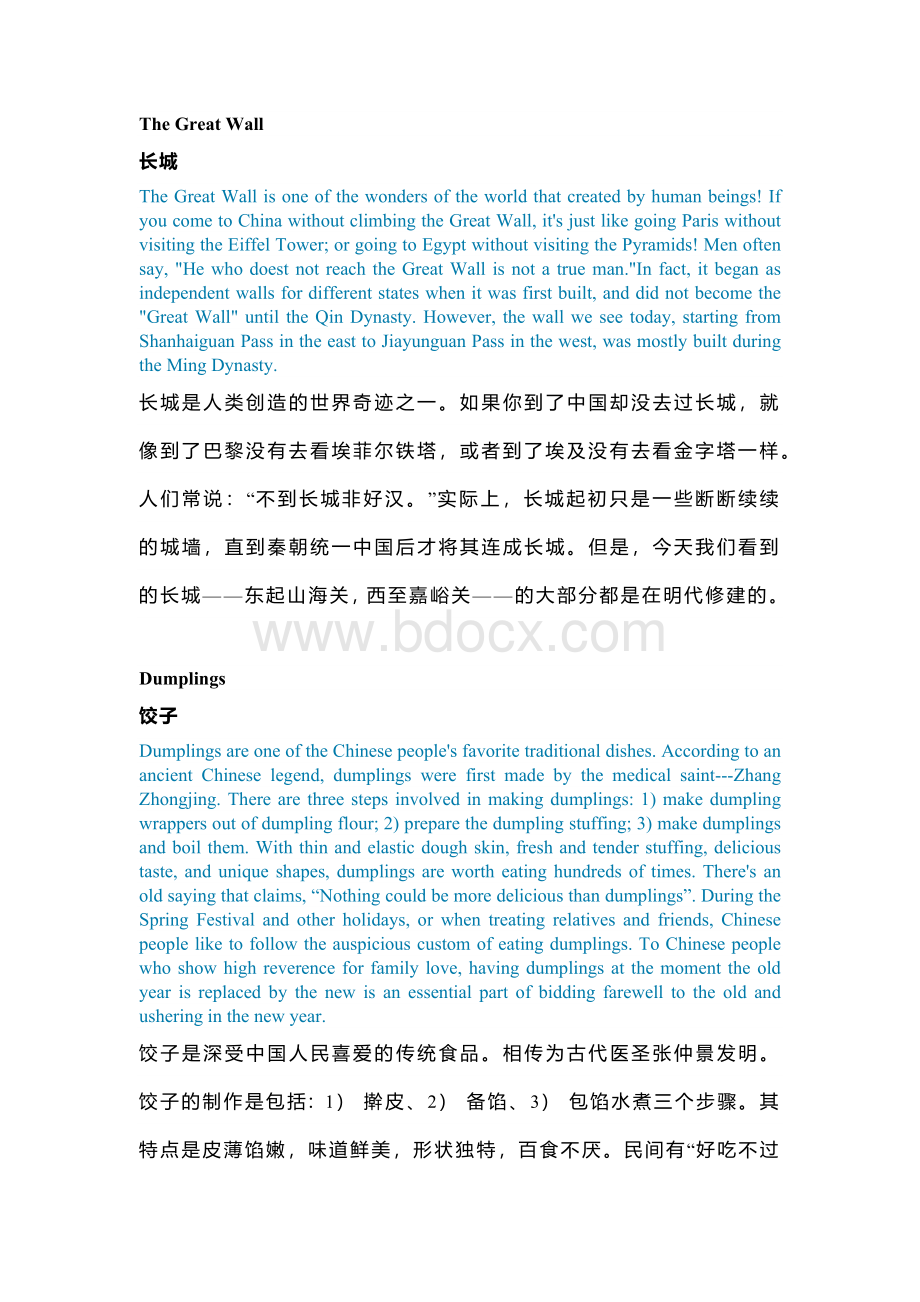高中英语16个传统文化素材.docx
《高中英语16个传统文化素材.docx》由会员分享,可在线阅读,更多相关《高中英语16个传统文化素材.docx(9页珍藏版)》请在冰豆网上搜索。

TheGreatWall
长城
TheGreatWallisoneofthewondersoftheworldthatcreatedbyhumanbeings!
IfyoucometoChinawithoutclimbingtheGreatWall,it'sjustlikegoingPariswithoutvisitingtheEiffelTower;orgoingtoEgyptwithoutvisitingthePyramids!
Menoftensay,"HewhodoestnotreachtheGreatWallisnotatrueman."Infact,itbeganasindependentwallsfordifferentstateswhenitwasfirstbuilt,anddidnotbecomethe"GreatWall"untiltheQinDynasty.However,thewallweseetoday,startingfromShanhaiguanPassintheeasttoJiayunguanPassinthewest,wasmostlybuiltduringtheMingDynasty.
长城是人类创造的世界奇迹之一。
如果你到了中国却没去过长城,就像到了巴黎没有去看埃菲尔铁塔,或者到了埃及没有去看金字塔一样。
人们常说:
“不到长城非好汉。
”实际上,长城起初只是一些断断续续的城墙,直到秦朝统一中国后才将其连成长城。
但是,今天我们看到的长城——东起山海关,西至嘉峪关——的大部分都是在明代修建的。
Dumplings
饺子
DumplingsareoneoftheChinesepeople'sfavoritetraditionaldishes.AccordingtoanancientChineselegend,dumplingswerefirstmadebythemedicalsaint---ZhangZhongjing.Therearethreestepsinvolvedinmakingdumplings:
1)makedumplingwrappersoutofdumplingflour;2)preparethedumplingstuffing;3)makedumplingsandboilthem.Withthinandelasticdoughskin,freshandtenderstuffing,delicioustaste,anduniqueshapes,dumplingsarewortheatinghundredsoftimes.There'sanoldsayingthatclaims,“Nothingcouldbemoredeliciousthandumplings”.DuringtheSpringFestivalandotherholidays,orwhentreatingrelativesandfriends,Chinesepeopleliketofollowtheauspiciouscustomofeatingdumplings.ToChinesepeoplewhoshowhighreverenceforfamilylove,havingdumplingsatthemomenttheoldyearisreplacedbythenewisanessentialpartofbiddingfarewelltotheoldandusheringinthenewyear.
饺子是深受中国人民喜爱的传统食品。
相传为古代医圣张仲景发明。
饺子的制作是包括:
1) 擀皮、2) 备馅、3) 包馅水煮三个步骤。
其特点是皮薄馅嫩,味道鲜美,形状独特,百食不厌。
民间有“好吃不过饺子”的俗语。
中国人接亲待客、逢年过节都有包饺子吃的习俗,寓意吉利。
对崇尚亲情的中国人来说,“更岁交子”吃饺子,更是欢度除夕、辞旧迎新必不可少的内容。
ChineseChopsticks
筷子
TheChinesewayofeatingwithchopsticksisuniqueintheworld.Therecordedhistoryofchopsticksstartedmorethanthreethousandyearsago.ChopstickswerenamedzhuinancientChinese.Theylookdeceptivelysimpletouse,butpossessmulti-variousfunctions,suchasclamping,turningover,liftingup,raking,stirring,scooping,poking,tearing,andsoon.ChopsticksweretakenasanauspiciousmascotbyordinarypeopleinancientChina.Forexample,thepartialtoneofchopsticksisoftenusedbypeopleasametaphoratweddingstoindicateablessingorbenedictionforthecoupletohaveababysoon.Unlikeusingaknifeandforkorone'sownhands,apairofchopsticksalsoimpliesthemeaningof“Harmonyiswhatmatters”.ChopsticksarehighlypraisedbyWesternersasahallmarkofancientorientalcivilization.
中国人使用筷子就餐的方式在世界上独树一帜。
有史记载用筷的历史已有三千多年。
筷子古时称为箸,它看似简单,但却同时具有夹、拨、挑、扒、拌、撮、戳、撕等多种功能。
中国民间视筷子为吉祥之物,如婚俗中将筷子隐喻为快生贵子的祝福等。
与使用刀叉以及手抓的方式不同,成双结对的筷子含有“和为贵“的意蕴。
西方人赞誉筷子是古老的东方文明。
Chinesekungfu
中国功夫
Chinesekungfu,orChinesemartialarts,carriestraditionalChinesecultureinabundance.Itisa traditionalChinesesportwhichappliestheartofattackanddefenceincombatandthemotionsengagedwithaseriesofskillandtricks.ThecoreideaofChinesekingfuisderivedfromtheConfuciantheoryofboth“themeanandharmony”and“cultivatingqi”(otherwiseknownasnourishingone'sspirit).Meanwhile,italsoincludesthoughtsofTaoismandBuddhism.Chinesekungfuhasalonghistory,withmulti-varioussectsandmanydifferentboxingstyles,andemphasizescouplinghardnesswithsoftnessandinternalandexternaltraining.Itcontainstheancientgreatthinkers' ponderingoflifeandtheuniverse.Theskillsinwieldingthe18kindsofweaponsnamedbythelatergenerationsmainlyinvolvetheskillsofbare-handedboxing,suchasshadowboxing(Taijiquan),formandwillboxing(Xingyiquan),eighttrigrampalm(Baguazhang),andtheskillsofkungfuweaponry,suchastheskillofusingswords,spears,two-edgedswordsandhalberds,axes,tomahawks,kooks,prongsandsoon.
中国功夫即中国武术,是将技击寓于搏斗和套路运动之中的中国传统体育项目,承载着丰富的中国民族传统文化。
其核心思想是儒家的中和养气之说,同时兼容了道家、释家的思想。
中国武术源远流长、流派林立、拳种繁多,讲究刚柔并济、内外兼修,蕴含着先哲们对生命和宇宙的参悟。
后世所称十八般武艺,主要指:
徒手拳艺,如太极拳、形意拳、八卦掌等;器械功夫,如刀枪剑戟、斧钺钩叉等。
Chinesecharacters
汉字
Chinesecharacterswereinitiallymeanttobesimplepicturesusedtohelppeoplerememberthings.Afteralongperiodofdevelopment,itfinallybecameauniquecharactersystemthatembodiesphoneticsound,image,idea,andrhymeatthesametime.Thewritingsystem,whichwasextremelyadvancedinancienttimes,beganwithinscriptionsonbonesandtortoiseshells,andtheseareregardedastheoriginalformsofChinesecharacters.Afterwards,Chinesecharacterswentthroughnumerouscalligraphicstyles:
bronzeinscriptions,officialscript,regularscript,cursivescript,runningscript,etc.Chinesecharactersareusuallyroundoutsideandsquareinside,whichisrootedinancientChinesebeliefsofanorbicularskyandarectangularEarth.ThefivebasicstrokesofChinesecharactersare“一“(thehorizontalstroke)“丨”(theverticalstroke),“丿”(theleft-fallingstroke),“乀”(theright-fallingstroke),and“乛”(theturningstroke).
汉字是从原始人用以记事的简单图画,经过不断演变发展,最终成为一种兼具音、形、意韵的独特文字。
现存中国古代最早成熟的文字是甲骨文,被认为是现代汉字的雏形。
此后,汉字又经历了金文、隶书、楷书、草书、行书等不同的阶段。
汉字结构“外圆内方“, 源于古人”天圆地方“的观念。
汉字有五种基本笔画,即:
横、竖、撇、捺、折。
Yangko
秧歌
YangkoisoneoftraditionfolkdanceofHaninChina.Itisusuallyperformedinnorthernprovinces.Thedancersusuallywearcolorfulandlightcostumes,andtheperformanceispowerfulandrapid.DuringsomefestivalssuchasSpringFestival,LanteinFestival,ifpeoplehearthesoundofdrumandgong,nomatterhowcoldtheweatheris,theywillcometostreetandappreciatetheYangko.Recentyears,theoldpeopleincityofeast-northernofChinaorganizedtheteamofYangkobythemselves,theteamerskeeptheirhealthbydancingYangkothewholeyear.
秧歌舞是中国汉族的一种民间传统舞蹈,通常在北方省份表演。
秧歌舞者通常穿上明亮多彩的表演服装,他们的表演动作有力迅速。
在农历春节、元宵节等节日期间,人们一旦听到锣鼓声,不管外面天气有多冷,他们都会蜂拥到街上看秧歌舞表演。
近年来,中国东北某些城市的老年人自发组织了了秧歌队,队员常年通过跳秧歌舞来保持健康,同时他们也乐在其中。
Acupuncture
针灸
AcupunctureisanimportantpartoftraditionalChinesemedicine(TCM).Inaccordancewiththe“mainandcollateralchannels”theoryinTCM,thepurposeofacupunctureistodredgethechannelandregulateqiandblood,soastokeepthebody'syinandyangbalancedandachievereconciliationbetweentheinternalorgans.ItfeaturesintraditionalChinesemedicinethat“internaldiseasesaretobetreatedwithexternaltherapy”.Themaintherapyofacupunctureinvolvesusingneedlestopiercecertainacupointsofthepatient'sbody,oradoptingmoxibustiontostimulatethepatient’sacupointssoastostimulatethechannelsandrelievepain.Withitsuniqueadvantages,acupuncturehasbeenhandeddowngenerationaftergenerationandhasnowspreadallovertheworld.Nowadays,acupuncture,alongwithChinesefood,kungfu(otherwiseknownasChinesemartialarts),andtraditionalChinesemedicine,hasbeeninternationallyhailedasoneofthe“fournewnationaltreasures.” 针灸是中医学的重要组成部分。
按照中医的经络理论,针灸疗法主要是通过疏通经络、调和气血,来达到阴阳归于平衡,使脏腑趋于调和之目的。
其特点是“内病外治”。
主要疗法是用针刺入病人身体的一定穴位,或用艾火的温热刺激烧灼病人的穴位,以达到刺激经络。
治疗病痛的目的。
针灸以其独特的优势,流传至今,并传播到了世界,与中餐、功夫、中药一起被海外誉为中国的“新四大国粹”。
ChineseDragon
龙
DragontotemworshipinChinahasbeenaroundforthelast8,000years.TheancientsinChinaconsideredthedragon(orloong)afetishthatcombinesanimalsincludingthefish,snake,horseandoxwithcloud,thunder,lightningandothernaturalcelestialphenomena.TheChinesedragonwasformedinaccordancewiththemulticulturalfusionprocessoftheChinesenation.TotheChinese,thedragonsignifiesinnovationandcohesion.
对龙图腾的崇拜在中国大约已绵延了八千多年。
中国龙是古人将鱼、蛇、马、牛等动物与云雾、雷电等自然天象集合而成的一种神物。
中国龙的形成与中华民族的多元融合过程同步。
在中国人的心目中,龙具有振奋腾飞、开拓变化的寓意和团结凝聚的精神。
ChineseBeijingOpera
京剧
Praisedas“OrientalOpera”,BeijingOperaisagenuinenationalquintessenceofChina.Itoriginatedfrommanykindsofancientlocaloperas,especiallyhuibaninsouthernChina.Attheendofthe19thCentury,BeijingOperaevolvedandtookshape,becomingthegreatestkindofoperainChina.BeijingOperaisablendofperformingarts---song,speech,performance,acrobatixfightinganddance.BeijingOperaportraysandnarratestheplotandcharactersthroughstylizedacting.ThemaintypesofrolesinBeijingOperaaresheng(male),dan(youngfemale),jing(paintedface,male),andchou(clown,maleorfemale).
京剧被誉为“东方歌剧”, 是地道的中国国粹。
它起源于中国多种古老的地方戏剧,特别是南方的“徽班”。
到了19世纪末,京剧形成并成为中国最大的戏曲剧种。
京剧是综合性表演艺术,集唱(歌唱)、念(念白)、做(表演)、打(武)、舞(舞蹈)为一体,通过程式化的表演手段,叙述故事,刻画人物。
角色主要分生(男性)、旦(女性)、净(男性)、丑(男性女性皆有)四大行当。
ChineseIdioms
中国成语
Chineseidiomsrefertocomprehensiveandintegratedfixedphrasesandexpressions.Idiomsareestablishedandacceptedbyconstantusageandcommonpractice.Anidiomisalanguageunitthatislargerthanaword,buthasthesamegrammaticalfunctionasaword.MostChineseidiomsconsistoffourcharacters.Forexample,ziqiangbuxi(makeunremittingeffortstoimproveoneself),qingchuyulan(bluerthanindigo),andhoujibofa(successcomeswithtimeandeffort).Idiomsareextratedfromfolkproverbs,ancientworksofliterature,poems,fables,allusions,andwell-knownsayings.IdiomsareapartoftheChineselanguagethatareconciseandhavegreatvitality.
中国成语是汉语中意义完整的表示一般概念的固定词组或短语。
“成语”中的“成”即是约定俗成。
成语是比词大而语法功能又相当于词的语言单位。
绝大多数的中国成语由四个汉字组成,例如:
自强不息、青出于蓝、厚积薄发。
成语主要从民间谚语、古代文学作品、诗歌、寓言、典故、名言警句等方面提炼而成,是汉语语言中精炼而又富有生命力的一部分。
Silk
丝绸
Chinaisthehomeofsilk.Mulberryplanting,sericulture,silkreelingandthickeningareallgreatinventionsoftheancientChinese.AsearlyastheShangandZhouDynasties(1600BC-256BC),theChinesepeople'ssilk-weavingtechniqueshadreachedanextremelyhighlevel.DuringtheWesternHanDynasty(206BC-25AD),ZhangQian,anoutstandingdiplomat,travelledaroundcentralAsiaandconnected